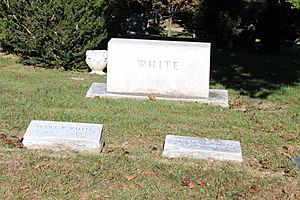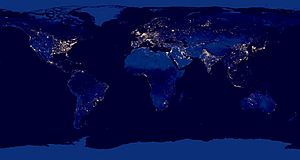Leslie White facts for kids
Quick facts for kids
Leslie White
|
|
|---|---|
| Born | January 19, 1900 |
| Died | March 31, 1975 (aged 75) |
| Nationality | American |
| Occupation | Anthropologist |
| Known for | Neoevolutionism |
Leslie Alvin White (born January 19, 1900, in Salida, Colorado – died March 31, 1975, in Lone Pine, California) was an American anthropologist. He was famous for his ideas about how human cultures change and develop over time, a theory called neoevolutionism. He also helped create the anthropology department at the University of Michigan Ann Arbor. White was even the president of the American Anthropological Association in 1964.
Contents
Early Life and Education
Leslie White grew up in Kansas and then Louisiana. When he was young, he joined the US Navy during World War I. After the war, he started studying at Louisiana State University in 1919.
In 1921, he moved to Columbia University in New York. There, he studied psychology and earned his first two degrees. Later, he got his Ph.D. (a very high degree) in Anthropology and Sociology from the University of Chicago in 1925.
White was interested in many subjects. He took classes in philosophy and even clinical psychiatry. He found his passion for anthropology through courses taught by Alexander Goldenweiser. For his Ph.D. research, he spent time with the Menominee and Winnebago Native American groups in Wisconsin. He also did fieldwork at Acoma Pueblo in New Mexico.
In 1927, White began teaching at the University at Buffalo.
Building a Department
Teaching at the University of Buffalo was a big moment for White. It was there that he started to form his strong ideas about anthropology, politics, and how people should live. He became interested in Marxism and even visited the Soviet Union in 1929.
White moved to the University of Michigan in 1930. He was hired to take the place of another anthropologist, Julian Steward. At first, White was the only professor in the anthropology department. He stayed at Michigan for the rest of his career. In 1932, he led a field school in the American Southwest, where he taught students like Fred Eggan.
In 1936, White brought one of his students, Mischa Titiev, to Michigan as a second professor. After World War II, other scholars like Richard K. Beardsley joined the department. White taught many students who became important anthropologists, including Robert Carneiro, Eric Wolf, and Marshall Sahlins.
White's Ideas on Culture
Leslie White had different ideas about anthropology compared to many other scholars of his time. He believed that culture could be studied like a science.
He saw the world as having three main levels:
- Physical: Like rocks and planets.
- Biological: Like plants and animals.
- Cultural: Like human societies, traditions, and tools.
White believed that anthropologists should focus on studying the cultural level. He called this study "culturology." He thought that culture was a "superorganic" thing, meaning it existed beyond individual people and had its own rules.
How Culture Evolves
White's most famous idea was about cultural evolution. He believed that human culture as a whole was always developing and becoming more complex. He thought this development was mainly driven by technology.
He divided culture into three parts:
- Technological: This includes tools, machines, and how people use them to interact with nature. White saw this as the most important part.
- Social Organizational: This is how people organize themselves in groups, like families, governments, and laws.
- Ideological: This includes ideas, beliefs, symbols, and art.
White argued that the technological part of culture was the most important. He called it "the hero of our piece." He believed that changes in technology led to changes in how societies were organized and what people believed.
White's Law of Cultural Evolution
White developed a rule, often called White's Law, to explain how culture evolves. He said that the main way to measure how advanced a culture is, is by how much energy it can capture and use.
He explained that cultures develop by:
- Finding ways to get more energy.
- Using that energy more efficiently.
White described five stages of human development based on energy use:
- People use only their own muscle energy.
- They start using the energy of domesticated animals.
- They learn to use the energy of plants through farming (the agricultural revolution).
- They discover how to use energy from natural resources like coal, oil, and gas.
- They learn to use nuclear energy.
He even created a formula to show this:
- P = ET
Where:
- P stands for the level of cultural development.
- E is the amount of energy used per person each year.
- T is how efficiently that energy is used.
So, according to White, as societies get better at getting and using energy, their culture becomes more developed. His ideas helped bring back interest in studying how societies change over long periods.
Selected Publications
- Ethnological Essays: Selected Essays of Leslie A. White. University of New Mexico Press. 1987.
- The Evolution of Culture: The Development of Civilization to the Fall of Rome. 1959.
- The Science of Culture: A study of man and civilization. Farrar, Straus and Giroux, 1949.
- The Pueblo of Santa Ana, New Mexico. American Anthropological Association Memoir 60, 1949.
- The Pueblo of San Felipe. American Anthropological Association Memoir No. 38, 1938.
- The Pueblo of Santo Domingo. American Anthropological Association Memoir 60, 1935.
- The Acoma Indians. Bureau of American Ethnology, 47th annual report, pp. 1–192. Smithsonian Institution, 1932.
See also
- List of important publications in anthropology
 In Spanish: Leslie White para niños
In Spanish: Leslie White para niños



